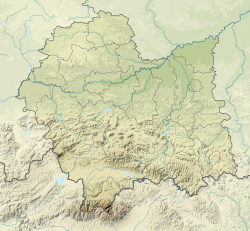| Izaak Synagogue | |
|---|---|
| Polish: Synagoga Izaaka | |
 The synagogue in 2007 The synagogue in 2007 | |
| Religion | |
| Affiliation | Orthodox Judaism |
| Rite | Nusach Ashkenaz |
| Ecclesiastical or organisational status | Synagogue |
| Status | Active |
| Location | |
| Location | 18 Kupa Street, Kazimierz, Kraków, Lesser Poland Voivodeship |
| Country | Poland |
 in Lesser Poland Voivodeship | |
| Geographic coordinates | 50°3′6″N 19°56′48″E / 50.05167°N 19.94667°E / 50.05167; 19.94667 |
| Architecture | |
| Architect(s) | Francesco Olivierri |
| Type | Synagogue architecture |
| Style | Baroque |
| Groundbreaking | 1638 |
| Completed | 1644 |
| Materials | Stone |
The Izaak Synagogue (Polish: Synagoga Izaaka), formally known as the Isaak Jakubowicz Synagogue, is an Orthodox Jewish congregation and synagogue, located at 18 Kupa Street, in the historic Kazimierz district of Kraków, in the Lesser Poland Voivodeship of Poland. Designed by Francesco Olivierri in the Baroque style and completed in 1644, the synagogue is named for its donor, Izaak Jakubowicz (d. 1673), also called Isaac the Rich, a banker to King Ladislaus IV of Poland.
History
The founding legend of the synagogue was first told by the early 19th-century Polish rebbe, Simcha Bunim of Peshischa. It went as follows: "Ayzik Jakubowicz, a pious but poor Jew, dreamed that there was treasure hidden under the old bridge in Prague. Without delay, he made his way there. On arrival, it turned out the bridge was guarded by a squad of soldiers and that digging was out of the question. Ayzik told the officer about his dream, promising him half of the booty. The officer retorted, "Only fools like Polish Jews can possibly believe in dreams. For several nights now I have been dreaming that in the Jewish town of Kazimierz there is hidden treasure in the oven of the home of the poor Jew Ayzik Jakubowicz. Do you think I am so stupid as to go all the way to Cracow and look for the house of this Isaac the son of Jacob?". Ayzik returned home immediately, took the oven apart, found the treasure and became rich. After this it was said: 'There are some things which you can look for the world over, only to find them in your own home. Before you realise this, however, you very often have to go on along journey and search far and wide.'"
During World War II
On 5 December 1939 the Gestapo came to the Kraków Judenrat building and ordered Maximilian Redlich, the Jewish official on duty that day, to burn the scrolls of the Torah. When Redlich refused he was shot dead.
Nazis destroyed the interior and furnishings, including the bimah and Aron Kodesh. After the war, the building was used by a sculpture and conservation atelier and then by a theatre company as workshop space and for the storage of props. Until recently it was an exhibition space. A fire in 1981 damaged the interior. A renovation was begun in 1983 and in 1989, with the fall of communism in Poland, the building was returned to the Jewish community. It is now a practicing Orthodox Synagogue once again.
Architecture
The interior walls of the early Baroque building are embellished with painted prayers, visible after conservation removed covering layers of paint. The vaulted ceiling is embellished with baroque plasterwork wreaths and garlands. Before the Nazi occupation of Poland, the synagogue boasted a widely-admired, wooden, baroque Aron Kodesh. When the building was planned, the design was considered by some diocesan officials to be too beautiful for Jews to have, which led to delays in the synagogue’s construction. The synagogue is considered to be "the most architecturally important" of all the old synagogues of Kraków. The women's gallery and exterior stairs leading to it are a later addition to the building.
Gallery
See also
- Chronology of Jewish Polish history
- Culture of Kraków
- History of the Jews in Poland
- List of active synagogues in Poland
- Synagogues of Kraków
References
- "Isaac Synagogue in Kraków". Historic Synagogues of Europe. Foundation for Jewish Heritage and the Center for Jewish Art at the Hebrew University of Jerusalem. n.d. Retrieved 31 July 2024.
- "Isaak Synagogue, Krakow, Poland". Sacred Destinations. Retrieved 4 August 2024.
- ^ Krinsky, Carol (1985). Synagogues of Europe. MIT University Press. p. 205.
- ^ "TRACES OF THE PAST". Dia-pozytyw. Archived from the original on 6 October 2008.
- Herzog, Henry Armin (2005). And Heaven Shed No Tears. University of Wisconsin Press. p. 39.
External links
![]() Media related to Isaac Synagogue of Kazimierz, Kraków at Wikimedia Commons
Media related to Isaac Synagogue of Kazimierz, Kraków at Wikimedia Commons
| Active | |||||
|---|---|---|---|---|---|
| Former |
| ||||
- 1644 establishments in the Polish–Lithuanian Commonwealth
- 17th-century synagogues in Poland
- 20th-century attacks on Jewish institutions
- Ashkenazi Jewish culture in Poland
- Ashkenazi synagogues
- Baroque architecture in Kraków
- Baroque synagogues in Poland
- Holocaust locations in Poland
- Orthodox synagogues in Poland
- Synagogues completed in 1644
- Synagogues in Kraków

